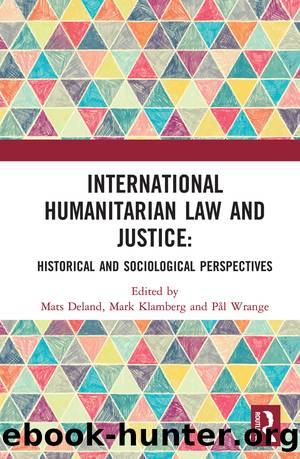International Humanitarian Law and Justice by Mats Deland Mark Klamberg Pål Wrange

Author:Mats Deland, Mark Klamberg, Pål Wrange [Mats Deland, Mark Klamberg, Pål Wrange]
Language: eng
Format: epub
Tags: Nonfiction, Reference & Language, Law, Comparative, History, Reference, Historiography
ISBN: 9781351104425
Publisher: Taylor and Francis
Published: 2018-09-18T04:00:00+00:00
9 Judging the past â international humanitarian law and the Luftwaffe aerial operations during the invasion of Poland in 1939
Mateusz PiÄ tkowski
9.1 Introduction
International humanitarian law (or the laws of war) is considered as the most fragile part of international law. The area that is governed by this set of rules and customs is inherently interfering with core aspects of state sovereignty. It tends to limit the inflexible right of every state to wage war. This creates a potential area of disagreement among the nations. At the same time, the weaponry used in war is increasingly efficient, and the humanitarian perspective of warfare is undermined. The arrival of new means and methods of combat is always a clear challenge for the existing legal framework. Such mechanisms reappeared in the beginning of the 20th century when the first military aircrafts were deployed in combat roles, and unfortunately, it is still topical in the contemporary world with the introduction of the lethal autonomous devices. The source of the issue is related to reluctance of states to adopt an acceptable level of limitation of the course of warfare. Another problem arises from technical argumentation, which is usually on an early stage of its development, indicating no concrete yardstick.
Those considerations fit perfectly in the picture of the law of aerial warfare during the 20th century. The bombings of Warsaw, Rotterdam, London, Hamburg, Tokyo and Dresden are still subject to a long-lasting discussion, attracting attention from the legal and historical fields. In such a legal landscape, I decided to dedicate my research to both contemporary and historical aspects of aerial warfare in the light of the relevant ius in bello provisions. This case study, which concerns the Second World War bombardments, is substantially important to better understand the blurred connections between law, technology and international relationships. In this respect, the presented background of the bombing of the Polish town WieluÅ in September 1939 is particularly significant, as it was among the first acts of this war, awakening the need of detailed examination from the perspectives of history and law.
Without warning, without appeals or an official declaration of war, and accompanied by the thunder from guns from the border, between 4.40 and 5.40 a.m. on the 1st of September 1939, a formation of 30 Ju-87 Junkers dive bombers began a deadly run above the provincial town close to the German-Polish border. The locality burned in the flame of incendiary bombs, which would become a prelude for a new type of warfare. The discussion about the legality of air bombardments during the Second War World has not mentioned the tragedy of this city, or the serious international humanitarian law issues of the first organized air operation in the Second World War. The point of this article is to consider the existence and the role of the rules covering aerial warfare at the time and to find the answer to the question how international law protected or could have protected the inhabitants of WieluÅ at the dawn of 1st September 1939.
Download
This site does not store any files on its server. We only index and link to content provided by other sites. Please contact the content providers to delete copyright contents if any and email us, we'll remove relevant links or contents immediately.
Tor and the Dark Net · Remain Anonymous Online and Evade NSA Spying (Tor, Dark Net, Anonymous Online, NSA Spying) by Smith James(202)
The Love Conspiracy: An Age-Gap Lesbian Romance by Arias J.J(158)
If We Burn by Vincent Bevins(144)
Women before the court by Lindsay R. Moore(116)
Witches, Wife Beaters, and Whores by Elaine Forman Crane(102)
Defensive Nationalism by B. S. Rabinowitz;(102)
Covering Muslims by Erik Bleich;A. Maurits van der Veen;(101)
The Crimes of Womanhood by A. Cheree Carlson(99)
The Will to Punish by Fassin Didier;Kutz Christopher;(98)
Sexual Violence in Conflict and Post-Conflict Societies by unknow(95)
Defining Girlhood in India by Ashwini Tambe(94)
To Raise and Discipline an Army by Joshua Kastenberg(90)
Critique of the Legal Order by Richard Quinney Randall G. Shelden(90)
Police Matters by Radha Kumar(87)
International Humanitarian Law and Justice by Mats Deland Mark Klamberg Pål Wrange(84)
History and Power in the Study of Law by June Starr Jane F. Collier(82)
Class Unknown by Mark Pittenger(81)
A New Daddy by orphan_account(80)
Grim Justice by Synova Cantrell(78)
